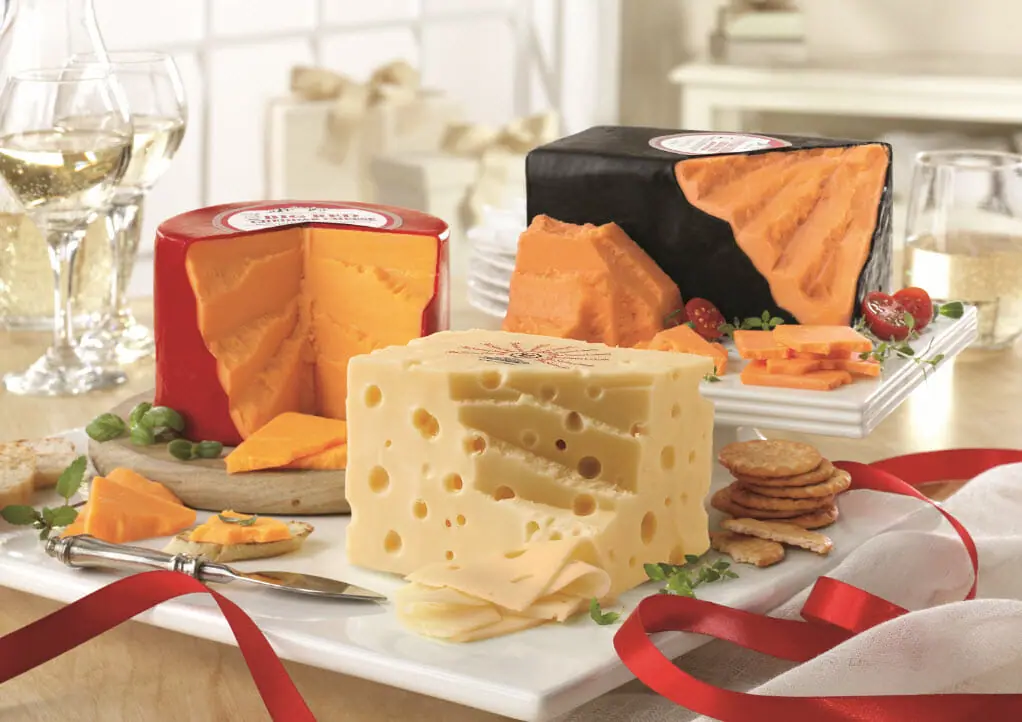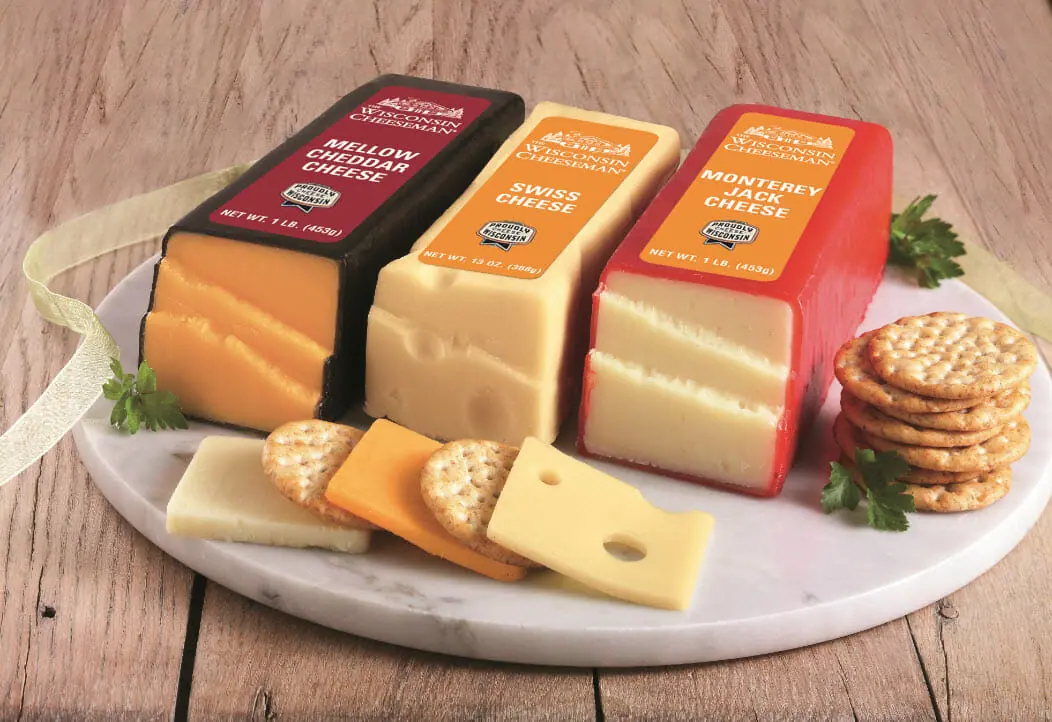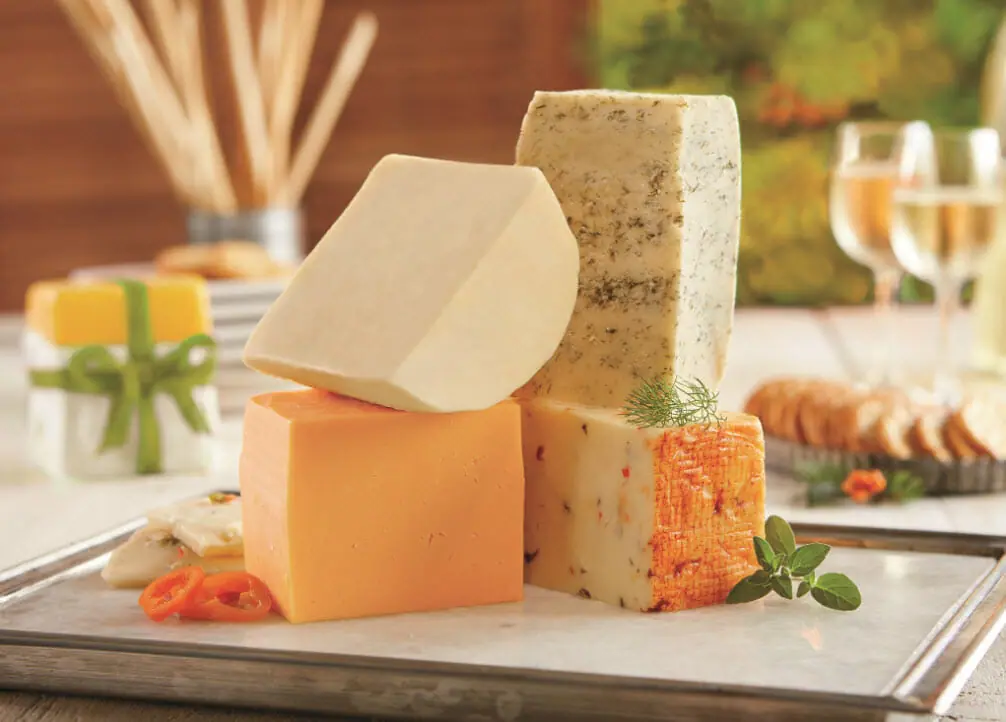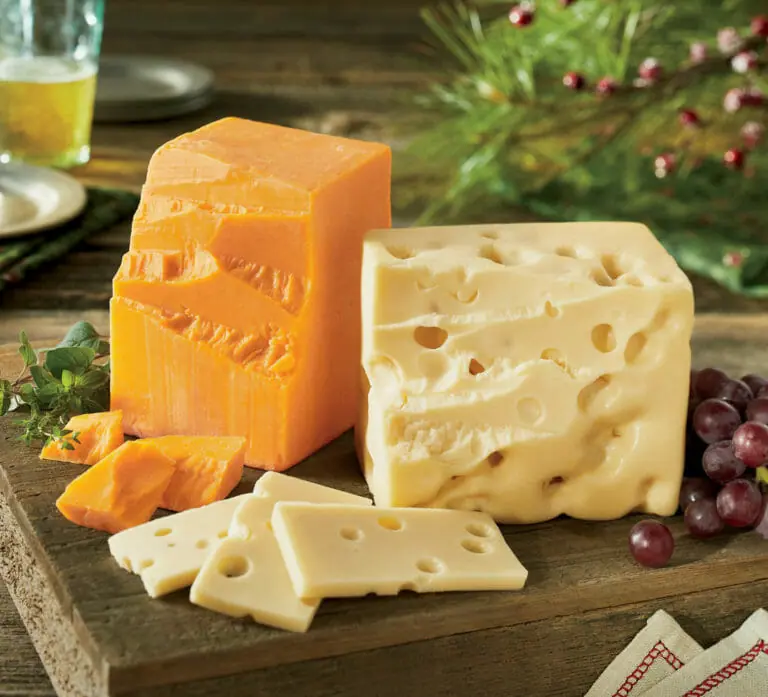The Most Popular Cheeses In The World
What are the most popular cheeses in the world? Take a world tour of cheese consumption by country, and learn about the most popular cheese in each country, including America.
So where is cheese popular, and which cheeses are preferred? We’ll take you on a world tour of cheese consumption by country, and learn about the most popular cheese in America, and the most popular cheeses in the world.

Cheese Consumption by Country
Whether cheesemaking started in the mountains of western Europe or got there via trade routes from the Arab world, Europe is certainly where it took hold and flourished. A big reason for this—and a reason you don’t find cheese in many regions—is genetic.
Most of the world’s population is lactose intolerant; once children stop breastfeeding, their bodies reduce production of the lactase necessary for digesting milk. But because of varying protein sources in different regions of the world, indigenous peoples learned to adapt. While 95% of Caucasians are lactase retentive and continue to properly digest dairy, the figure drops to 50% for people of African descent and only about 5% of east Asians. This is why you almost never find milk, cheese, or dairy products in Asian food, and why cheese consumption by country varies so widely.
So, who eats the most cheese? According to a report by the International Dairy Federation, the top 10 countries for cheese consumption per capita (in 2023) are:
- France – 57.9 pounds per year
- Germany – 53.2 pounds per year
- Luxembourg – 53.2 pounds per year
- Iceland – 53.2 pounds per year
- Greece – 51.5 pounds per year
- Finland – 49.5 pounds per year
- Italy – 48 pounds per year
- Switzerland – 48 pounds per year
- Estonia – 45.8 pounds per year
- Netherlands – 42.7 pounds per year
Not surprisingly, each and every one of those countries falls squarely in that European sweet spot for lactose tolerance. France, in particular, is known for producing the most varieties of cheese (and for staying slim while eating a lot of it)…but what, no United States?
Even though the U.S. produces the most cheese in the world, it falls outside the top 10 in per-capita consumption at 34.1 pounds per year. That’s less than Austria, Sweden, Cyprus, Norway…even Israel. And Great Britain, the ancestral home of Cheddar, produces more varieties of cheese per capita than any other country but only consumes 25.7 pounds per capita annually.
Now, of course, the United States is much larger than those European countries, and certainly consumes the most cheese as a nation. According to the Wisconsin Milk Marketing Board, the U.S. leads the world in cheese production at 11.1 billion pounds, followed by Germany at 4.81 billion, France at 4.27 billion, and Italy at 2.55 billion.
The leading state in the U.S. for cheese production is Wisconsin. If the state of Wisconsin were a country, it would rank fourth in the world in terms of total cheese production at 2.86 billion pounds, behind the remaining U.S., Germany, and France, and just ahead of Italy.

The Most Popular Cheeses in the World
In the parts of the world where cheese is made, you will find different types favored in different regions. In the Mediterranean and Middle East, where preservation was a challenge in the hotter climate, cheese was made by heavily salting the curds, which is why feta is the most famous cheese from Greece. In the cooler parts of Europe (the Alps and north), where caves and ice provided refrigeration, a variety of fresher cheeses (like Gouda or Havarti) could be enjoyed. Naturally, when European immigrants came to America they brought their native preferences with them.
Let’s count down the top international cheese-producers, with the most popular cheese in each country (we’ll put Wisconsin back with the rest of the U.S. where it belongs; the favorite cheese is still the same, anyway).
Italy: Parmigiano-Reggiano Cheese
There are many varieties of grana (hard cheeses used for grating), but the “king of cheeses” is the one named for the cities of Parma and Reggio in the Emilia-Romagna region. There is really no better in the world than the Parmigiano-Reggiano.
Italian cheeses are among the most diverse and beloved in the world, with a rich history and unique traditions dating back centuries. From the sharp and nutty Parmigiano-Reggiano to the soft, creamy burrata and mozzarella to aged Pecorino Romano, Italian cheeses offer a wide range of textures and flavors that reflect the country’s diverse regions and culinary heritage. Each cheese is carefully crafted using traditional techniques. Whether enjoyed on their own, in salads, or as a topping for pasta or pizza, Italian cheeses are a delicious and essential part of Italian cuisine.
France: Camembert Cheese
The Camembert is a soft, buttery cheese is creamy and spreadable at room temperature. It is almost identical to Brie, but comes from a different region of France (Normandy) and is typically made in smaller wheels. Both have a white, bloomy rind and rich, earthy mushroom flavor that gets stronger with age.
French cheeses are renowned worldwide for their quality, variety, and rich history. With over 400 distinct types of cheese produced across the country, France boasts the most extensive cheese-making tradition in the world. From the soft and creamy brie to the tangy roquefort and the nutty comté, French cheeses represent the country’s diverse regions and culinary traditions.
The cheese-making process in France often involves artisanal techniques and strict regulations to ensure the highest quality, and the country’s cheese culture is deeply ingrained in its culinary heritage. French cheeses are often enjoyed on their own, paired with wine, or used as a key ingredient in classic French dishes such as quiches and fondue. Overall, French cheeses are an essential part of French cuisine and a source of national pride.
Germany: Allgäu Emmental Cheese
Also known as “Bavarian Swiss”, this Alpine-style cheese is Germany’s version of Switzerland’s Emmentaler. Allgäu Emmental is a semi-hard cheese with distinctive holes, or “eyes”, and a buttery, nutty, full flavor.
German cheeses may not be as well-known as those from other European countries, but they are no less delicious or diverse. German cheese-making traditions date back centuries, with a range of regional specialties. From the tangy and aromatic Limburger to the creamy and mild butterkäse, German cheeses offer a unique range of flavors and textures that reflect the country’s varied landscapes and culinary heritage. In addition to classic cheeses, Germany is also known for producing Quark, a fresh cheese that is similar to yogurt and often used in sweet and savory dishes.
While German cheeses may not have the same international recognition as some of their European counterparts, they are an essential part of German cuisine and a testament to the country’s rich culinary history.

The Most Popular Cheese in America
The United States, being a nation of immigrants, can’t really claim a truly indigenous cheese. (Native Americans had no dairy in their diet.) While there are original American cheeses, they are all based on European recipes and techniques adapted to local resources and tastes.
Because of the British colonial influence, the first cheeses made in the U.S. were all Cheddar cheese. Swiss immigrants in the mid-1800s introduced traditional Emmentaler and later developed other Swiss-style cheeses, and Germans, Italians and other Europeans followed suit, spreading these traditions through the Eastern and Midwestern states.
Meanwhile, in the American Southwest, Hispanic-style cheeses gained popularity. These cheeses originated with the Spanish colonists, who intermixed with the indigenous population and let their cheesemaking evolve accordingly. Rather than adhering strictly to the original European recipes, cheeses like Oaxaca, queso blanco and Chihuahua are unique New World creations.

According to a report by the International Dairy Foods Association, Americans consume more Italian-style cheeses than other types, followed by American-style cheeses. (This includes Cheddar.) Americans are also eating increasingly more natural cheeses and less processed cheese.
As our demographics change, Swiss cheese consumption is declining as Hispanic cheese consumption continues to rise. But Italian-style and Cheddar cheeses are steadily increasing in popularity. The Italian-style cheeses lead mostly because of the copious amounts of mozzarella smothering American pizza, while the clear champion for everyday eating is Cheddar.
Wisconsin, as previously noted, leads the U.S. in Cheddar production…and in fact, makes almost as much as does the entire United Kingdom. In fact, if you want to take a world tour of the most popular cheeses, you can pretty much do it all with domestic cheeses instead of trying to track down all the originals noted above. Start with an award-winning Wisconsin Parmesan, ease into a smooth, creamy Brie, savor a nutty, buttery Swiss cheese descended from the famous Emmentalers, and finish with a razor-sharp Wisconsin Cheddar cheese.

How Many Types of Cheese Are There?
It is difficult to give an exact number of how many types of cheese there are, as the number can vary depending on the classification system used and how one defines a “type” of cheese. However, there are estimated to be over 1,800 different types of cheese worldwide.
Cheeses can be classified based on a variety of factors such as their texture (soft, semi-soft, semi-hard, or hard), their country or region of origin, their milk source (cow, goat, sheep, buffalo, or other animals), and their method of production (raw milk, pasteurized, aged, or fresh).
Some common cheese types include cheddar, mozzarella, brie, feta, gouda, camembert, blue cheese, parmesan, and Swiss cheese. Each of these types of cheese has its own unique flavor, texture, and culinary uses.
In addition to these commonly known types of cheese, there are also many lesser-known regional and artisanal varieties that can be found throughout the world.

When Was Cheese Invented?
The exact origins of cheese are unknown, as it is believed to have been discovered accidentally. However, there is evidence that cheese-making dates back at least 7,000 years, as ancient artifacts have been found in countries such as Poland, Hungary, and Switzerland that suggest cheese was being made during that time.
However, one legend places the origin of cheese in the Middle East. Supposedly an Arab merchant made it by accident when he prepared for a journey across the desert by putting a supply of milk in a pouch made from a sheep’s stomach. The natural rennet from the stomach lining, combined with the sun’s heat, caused the milk to separate and curdle. When he reached his destination, the curds had a fabulous flavor, and the watery whey satisfied his thirst. While whey protein drinks would take awhile to catch on, cheese became an instant hit and an important food in much of the world.





Comments (25)
Didi Brant
In Holland we had a dry cheese that smelled like the worst stinky feet but was very tasty. When brave enough to try, it was loved. Sold in a little cone-shaped carton. So long, no see but think it was called Volendam ( town in N. Holland province) kaas. Similar to Parmegian but stronger and in my memory much stinkier than Limburger ( a Dutch province) cheese.
20 Grocery Items You Should Never Pay Full Price For - Critical Financial
[…] U.S. is the world’s number 1 cheese producer, says Wisconsin Cheeseman, and we have a reason why cheese lovers can rejoice! There’s no need to shell out big bucks for […]
Wisconsin's top 10 cheeses
[…] If the state of Wisconsin were a country, it would rank fourth in the world in total cheese production at 2.86 billion lbs./year, behind the entire US, Germany, and France, and just ahead of […]
Brian Harris
I’m going to try something different with my next batch of pepper jack cheese. I’m going to take the milk and put it in wide pans in my electric smoker and set it at a low temperature setting and Hickory/Maple smoke the milk overnight and go from there. Or I could cheat and just add some liquid smoke to the milk before curdling it. One things for sure. No one is going to forget when they took a bite of my Hickory Habanero and Scorpion pepper jack!
Birgitta M. Small
I am very suprised that Denmark is not on top of the list. Their Danish Port Salut was in my opinion superior to the French Port Salut but it may not be fair to compare the two. Apparently Denmark decided to change the name to Estrom which continues to be a favorite in the San Francisco Bay Area of California, probably by European immigrants, but unfortunately the vendors representing the Estrom always seem to be sold out. According to the Marina Market in the Seattle area in the State of Washington, they are having difficulty with timely deliveries out of Denmark. It’s a semi-soft slightly smelly sliceable cheese. My favorite of all and I remember it well from my childhood. The Swedish Herrgardsost is also great as are various Farmer’s cheeses also from Scandinavia. But nothing compares with the Danish Estrom and I wish it were easier to locate over here.
Rise and Shine: Tuesday, Feb. 13, 2024 - CivMix
[…] produced in the New World. Today, Wisconsin leads the pack in cheddar production. According to one website, it makes almost as much cheddar in a single state as the entire United Kingdom. (FWIW, cheddar […]
Eileen Quimby
My favorites were creamy blue like gorgonzola, cheddar and havarti. I recently discovered Jarlsburg swiss-a mild flavor and a medium texture makes great omelets and just eating slices solely or with crackers burgers or added to grilled cheese! Love this cheese!
Orange Cheese Is Not Natural, It’s Man Made | Roach News
[…] is has been crazy popular in Europe and North America! The French devours 57.9 pounds per person annually followed by the Germans and Italians. Chilly Iceland gobbles 53.2 […]
Orange Cheese Is Not Natural, It's Man Made - The Art Of MaryJane Media
[…] is has been crazy popular in Europe and North America! The French devours 57.9 pounds per person annually followed by the Germans and Italians. Chilly Iceland gobbles 53.2 […]
Iyad
Amazing! Thanks
Leslie Rowe
Copy
I agree with Loz, the UK produces over 700 types of cheese, that tops the French by around 100 varieties. Cheddar is insanely popular worldwide. I tihnk like a lot of things in life trying a poor version of any food will trigger reticence to try it again. Stilton is a prime example, Colston Basset is sensational and a good French friend of mine ports his Colston Basset every NY eve for his dinner party. I love cheese, clearly, but just like beer, the last 20 years has seen a huge resurgance in local small scale production. The produccts are made with finest ingredients, care and most of all love. Having travelled extensively and lived in a great many countries its nice to see certain products that are remarkably well recieved and consumed woldwide despite our much maligned image for all thing culinary on the international stage.
I agree with Loz, the UK produces over 700 types of cheese, that tops the French by around 100 varieties. Cheddar is insanely popular worldwide. I think like a lot of things in life trying a poor version of any food will trigger reticence to try it again. Stilton is a prime example, Colston Basset is sensational and a good French friend of mine ports his Colston Basset every NY eve for his dinner party. I love cheese, clearly, but just like beer, the last 20 years have seen a huge resurgence in local small scale production. The products are made with the finest ingredients care and most of all love. Having travelled extensively and lived in a great many countries its nice to see certain products that are remarkably well received and consumed worldwide despite our much maligned image for all thing culinary on the international stage.
The Best Cheddar Cheeses To Buy (20+ Taste Tested)
[…] in the world, cheddar cheese is the second most consumed cheese family in the United States (second only to Italian cheeses). Cheddar cheese is a staple in quesadillas, tapas platter, sauces, savory pies and […]
Eileen Johnson
I believe I use to buy Wisconsin Longhorn cheese to use in my potatoes AuGratin recipe. I can not find this cheese and my potatoes do not taste the same. Did you make this cheese? Taco Bell used this same taste in their food also in the 60’s and 70’s
severson
You’re thinking of Longhorn Colby. We don’t sell the Longhorn form (which is simply a different shape), but we do sell Colby.
Famous Cheeses from around the world – MIG Cheese Factory
[…] With close to 2,000 different options to choose from, it’s no wonder many still aren’t sure of their favourite. One thing we can guarantee though, is that if you’re not a cheese lover or have never even eaten it before, this list is probably a very good place to start exploring.References:https://www.tasteatlas.com/50-most-popular-cheeses-in-the-worldhttps://www.tasteatlas.com/most-popular-cheeses-in-the-worldhttps://www.wisconsincheeseman.com/blog/cheese-nation/popular-cheeses-world/https://www.trendmantra.com/15-well-known-cheeses-around-the-world/https://www.lovefood.com/gallerylist/70410/35-cheeses-you-must-try-once-in-your-life […]
Joel Leslie
Wheres the Gruyere ?
Loz
The UK has more cheese varieties than France. Yes I am a bona fide cheese smuggler.
Elias Waters
I am from cheddar myself and when someone says to me that cheddar isn’t famous i just say to them what do you call the cheese that is most commonly used world wide and they just say quietly cheddar cheese
written in the stars - thoughts from taryn
[…] making cheddar cheese a great match for them. Cheddar is a real classic, one of the most popular cheeses in the world, in […]
Ellie
I read somewhere that, worldwide, the most widely consumed cheese is Gouda, but I can’t find any real verification. I’d love to go to Wisconsin someday and just do a cheese tour!
John Mepham
I think the world’s top selling. cheese is cheddar whose British origin is from the village of Cheddar in Somerset, England. In Great Britain Canada,. Australia and New Zealand it is by far and away the top selling cheese; and second in the United States
adam
I am making a since project on pizza and cheese is a big part of it i need help
Cheese Person
Aweome!
Paul
Answers some questions I always wondered about. Thanks!
Best Cheese for Pizza: Mozzarella & Beyond
[…] discussion of the best cheese for pizza has to start with mozzarella. After all, mozzarella is the most popular cheese in America, and it’s all because of pizza. (The most popular cheese for snacking is […]